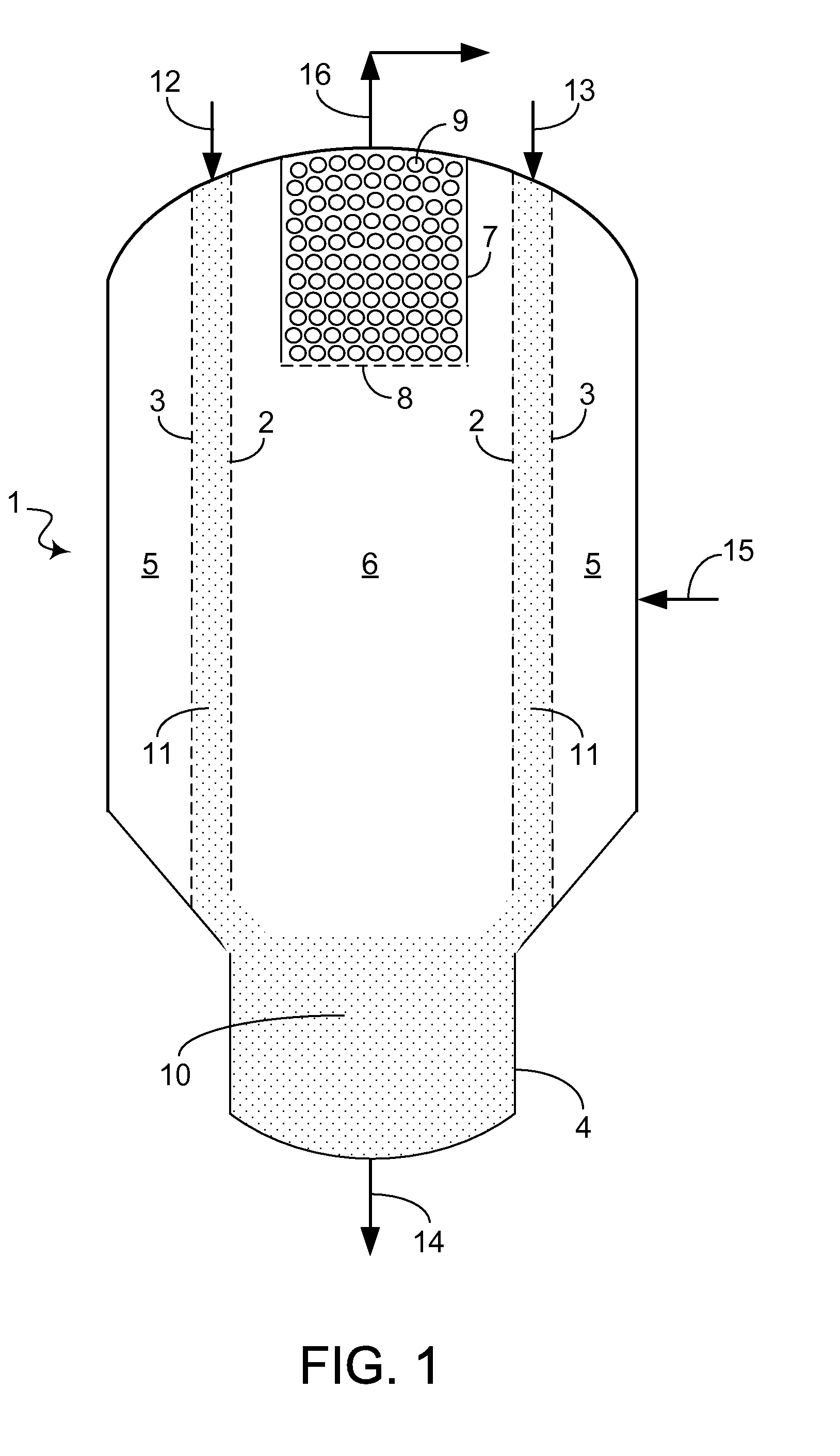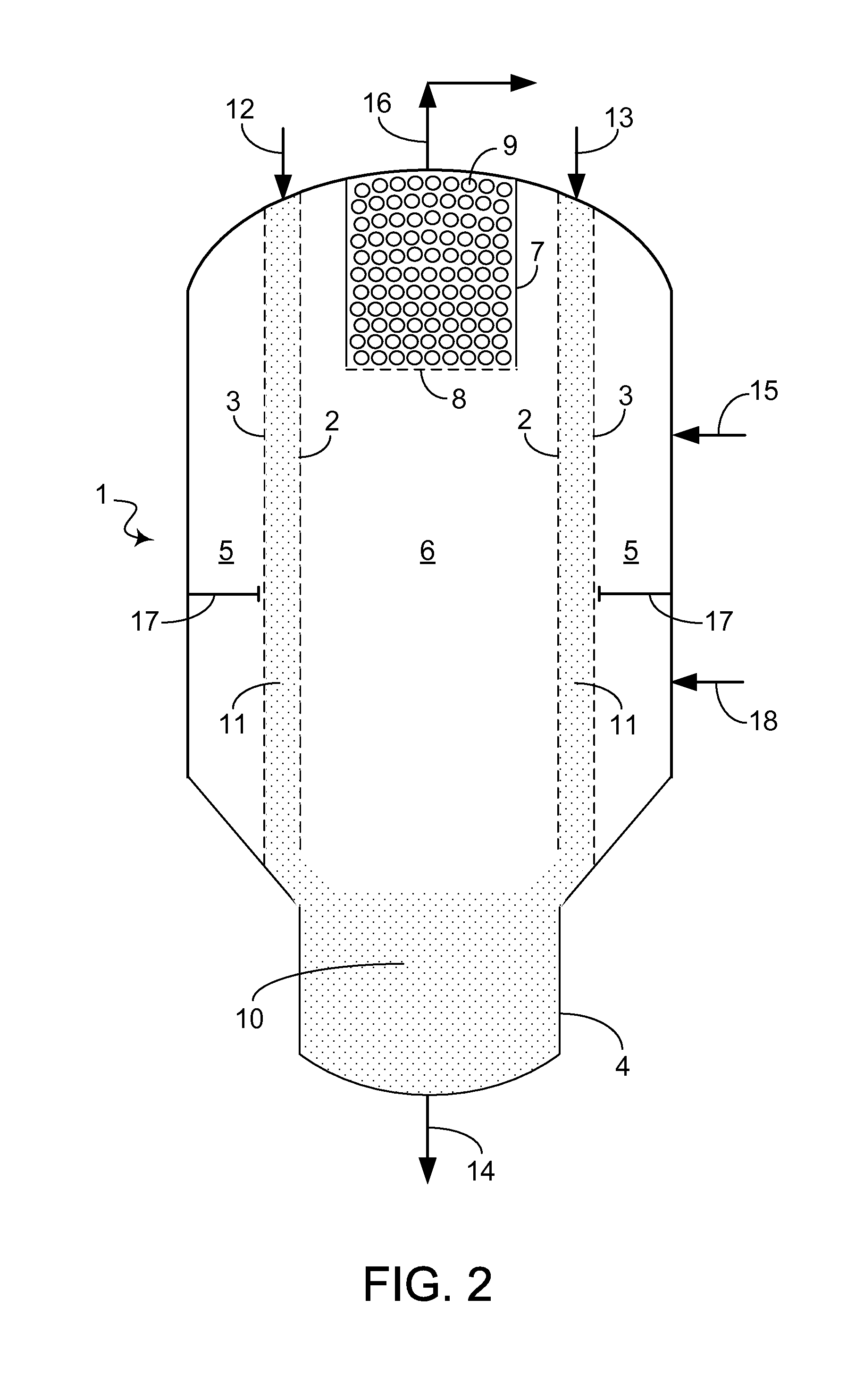[0003]When at least a portion of the
effluent flue gas stream is used as a
diluent for the
combustion gas stream which is charged to the moving bed regeneration apparatus (which is the typical case for a commercial unit) in order to control the
oxygen content at a relatively low level and to provide a
heat sink for at least some of the
heat of combustion liberated in the coke
combustion zone, the presence of hazardous amounts of CO in this stream can act to retard and / or inhibit the coke combustion reactions. An additional
advantage of the present invention in this situation is therefore that the coke combustion reactions are accelerated relative to what they would be in the absence of the present invention.
[0004]A major portion of the worldwide
petrochemical industry is concerned with the production of light olefin materials and their subsequent use in the production of numerous important
chemical products via
polymerization, oligomerization,
alkylation and the like well-known chemical reactions. Light olefins include
ethylene, propylene and mixtures thereof. These light olefins are essential building blocks for the modern
petrochemical and chemical industries. The major source for these materials in
present day refining is the steam
cracking of
petroleum feeds. For various reasons including geographical, economic, political and diminished supply considerations, the art has long sought a source other than
petroleum for the massive quantities of raw materials that are needed to supply the demand for these light olefin materials. In other words, the holy grail of the R & D personnel assigned to work in this area is to find a way to effectively and selectively use alternative feedstocks for this light olefin production application, thereby lessening dependence of the
petrochemical industry on
petroleum feedstocks. A great deal of the prior art's attention has been focused on the possibility of using
hydrocarbon oxygenates and more specifically
methanol or dimethylether (DME) as a prime source of the necessary alternative feedstock. Oxygenates are particularly attractive because they can be produced from such widely available materials as
coal,
natural gas, recycled plastics, various carbon waste streams from industry and various products and by-products from the agricultural industry. The art of making
methanol and other oxygenates from these types of raw materials is well established and typically involves the use of one or more of the following procedures: (1) manufacture of synthesis gas by any of the known techniques typically using a
nickel or
cobalt catalyst in a
steam reforming step followed by the well-known
methanol synthesis step using relatively
high pressure with a
copper-based catalyst; (2) selective
fermentation of various organic agricultural products and by-products in order to produce oxygenates; or (3) various combinations of these techniques.
[0005]Given the established and well-known technologies for producing oxygenates from alternative non-petroleum raw materials, the art has focused on different procedures for catalytically converting oxygenates such as methanol into the desired light olefin products in order to make an
oxygenate to olefin (OTO) process. These light olefin products that are produced from non-petroleum based raw materials must of course be available in quantities and purities such that they are interchangeable in
downstream processing with the materials that are presently produced using petroleum sources. Although many oxygenates have been discussed in the prior art, the principal focus of the two major routes to produce these desired light olefins has been on methanol conversion technology primarily because of the availability of commercially proven methanol synthesis technology. A review of the prior art has revealed essentially two major techniques that are discussed for conversion of methanol to light olefins (MTO). The first of these MTO processes is based on early German and American work with a catalytic conversion zone containing a zeolitic type of catalyst
system. Representative of the early German work is U.S. Pat. No. 4,387,263 which was filed in May of 1982 in the U.S. without a claim for German priority. This '263 patent reports on a series of experiments with methanol conversion techniques using a ZSM-5 type of catalyst
system wherein the problem of DME by-product recycle is a major focus of the technology disclosed. Although good yields of
ethylene and propylene were reported in this '263 patent, they unfortunately were accompanied by substantial formation of higher aliphatic and aromatic hydrocarbons which the patentees speculated might be useful as an engine fuel and specifically as a
gasoline-type of material. In order to limit the amount of this heavier material that is produced, the patentees of the '263 patent propose to limit conversion to less than 80% of the methanol charged to the MTO conversion step. This operation at lower conversion levels necessitated a critical assessment of means for recovering and recycling not only unreacted methanol but also substantial amounts of a DME
intermediate product. The focus then of the '263 patent invention was therefore on a DME and methanol scrubbing step utilizing a water
solvent in order to efficiently and effectively recapture the light olefin value of the unreacted methanol and of the intermediate reactant DME.
[0006]This early MTO work with a zeolitic catalyst
system was then followed up by the Mobil Oil Company who also investigated the use of a zeolitic catalyst system like ZSM-5 for purposes of making light olefins. U.S. Pat. No. 4,587,373 is representative of Mobil's early work and it acknowledged and distinguished the German contribution to this zeolitic catalyst based MTO
route to light olefins.
[0007]Primarily because of an inability of this zeolitic MTO
route to control the amounts of undesired C4+
hydrocarbon products produced by the ZSM-5 type of catalyst system, the art soon developed a second MTO conversion technology based on the use of a non-zeolitic
molecular sieve catalytic material. This
branch of the MTO art is perhaps best illustrated by reference to UOP's extensive work in this area as reported in numerous patents of which U.S. Pat. No. 5,095,163; U.S. Pat. No. 5,126,308 and U.S. Pat. No. 5,191,141 are representative. This second approach to MTO conversion technology was primarily based on using a catalyst system comprising a non-zeolitic
molecular sieve, generally a
metal aluminophosphate (ELAPO) and more specifically a silicoaluminophosphate
molecular sieve (SAPO), with a strong preference for a SAPO species that is known as SAPO-34. This SAPO-34 material was found to have a very
high selectivity for light olefins with a methanol feedstock and consequently very low selectivity for the undesired corresponding light paraffins and the heavier materials. This ELAPO catalyzed MTO approach is known to have at least the following advantages relative to the zeolitic catalyst
route to light olefins: (1) greater yields of light olefins at equal quantities of methanol converted; (2) capability of direct
recovery of
polymer grade ethylene and propylene without the necessity of the use of extraordinary
physical separation steps to separate ethylene and propylene from their corresponding paraffin analogs; (3) sharply limited production of by-products such as stabilized
gasoline; (4) flexibility to adjust the product ethylene-to-propylene weight ratios over the range of 1.5:1 to 0.75:1 by minimal adjustment of the MTO conversion conditions; and (5) significantly less coke make in the MTO conversion zone relative to that experienced with the zeolitic catalyst system.
[0008]The classical OTO technology produces a mixture of light olefins primarily ethylene and propylene along with various higher boiling olefins. Although the classical OTO process technology possesses the capability of shifting the major olefin product recovered therefrom from ethylene to propylene by various adjustments of conditions maintained in the
reaction zone, the art has long sought an
oxygenate to propylene (OTP) technology that would provide better yields of propylene relative to the classical OTO technology. The driving force for this shift in emphasis towards propylene is the growth rate of the propylene market versus the growth rate of the ethylene market. The existing sources of propylene production in the marketplace are primarily based on conventional steam
cracking of
naphtha, LPG streams,
propane streams and the like. Another major existing source of propylene is the olefins that are produced in a
fluid catalytic cracking (FCC)
hydrocarbon conversion process in the modern day
refinery. Because the basic
raw material used in an OTO process is derived from
natural gas which is widely available particularly in remote areas of the world but unfortunately markets for this gas are typically not conveniently available near the location of the remote gas fields. These remote gas fields tend to be quite large and because of the relatively well-developed technology for converting natural gas to methanol and other oxygenates are viewed by those skilled in this art and being the next logical source of large-scale propylene production provided a commercially acceptable OTP process can be established which possesses intrinsic
high selectivity for the desired propylene product.
 Login to View More
Login to View More 

